State Faraday’s law of electromagnetic induction. Figure shows a rectangular conductor PQRS in which the conductor PQ is free to move in a uniform magnetic field B perpendicular to the plane of the paper. The field extends from x = 0 to x = b and is zero for x > b. Assume that only the arm PQ possesses resistance r. When the arm PQ is pulled outward from x = 0 to x = 2b and is then moved backward to x = 0 with constant speed v obtain the expressions for the flux and the induced emf. Sketch the variations of these quantities with distance 0 ≤ x ≤ 2b.
Faraday’s law of electromagnetic induction states that whenever there is a change in magnetic flux linked with of a coil an emf is induced in the coil. The induced emf is proportional to the rate of change of magnetic flux linked with the coil.i.e. e∝Δϕ/Δt If the coil contains N-turns then e = - N Δϕ/ΔtLet length of conductor PQ =l As x = 0 magnetic flux ϕ = 0.When PQ moves a small distance from x to x + dx then magnetic flux linked = BdA = Bldx The magnetic field is from x = 0 to x = b so final magnetic flux = ∑Bldx =Bl∑dx = Blb increasing Mean magnetic flux from x = 0 to x = b is 1/2Blb. The magnetic flux from x = b to x = 2b is zeroDuring return from x = 2b to x = b the induced emf is zero; but now area is decreasing so magnetic flux is decreasing and induced emf will be in opposite direction. ε = Blv Graph is shown in figure.
Related Solutions
(a) State Faraday's law of electromagnetic induction. (b) Figure 6.60 shows a rectangular conductor PQRS in which the conductor PQ is free to move in a uniform magnetic field B perpendicular to the plane of the paper. The field extends from x = 0 to x =b and is zero for gt b . Assume that only the arm PQ possesses resistance r. When the arm PQ is pulled outward from x =0 to x = 2b and is then moved backward to x = 0 with constant speed v, obtain the expressions for the flux and the induced emf. Sketch the variations of these quantities with distance 0 le x le 2b .
View SolutionState Faraday.s law of electromagnetic induction. Figure shows a reactangular conductor PQRS in which the conductor PQ is free to move in a uniform magnetic field B perendicular to the plane of the paper. The field extends from to and is zero for . Assume that only the arm PQ possesses resistance r. When the arm PQ is pulled outward from to and is then moved backward to with constant speed v. Obtain the expressions for the flux and the induced emf. Sketch the variations of these quantities with distance .
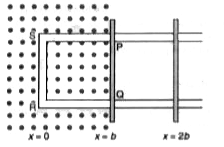
View SolutionFigure shows a rectangular conductor PQRS in which the conductor PQ is free to move in a uniform magnetic field B perpendicular to the plane of the paper.The field extends from x=0 to x=b and is zero for x>b.Assume that only the arm PQ posses resistance r.When the arm PQ is pulled outward from x=0 with constant speed v, obtain the expressions for the flux and the induced emf with distance 0≤x≤2b

View SolutionState Faraday's law of electromagnetic induction. Figure shows a rectangular conductor PQRS in which the conductor PQ is free to move in a uniform magnetic field B perpendicular to the plane of the paper.The field extends from x=0 to x=b and is zero for x gt b .Assume that only the arm PQ posses resistance r .When the arm PQ is pulled outward from x=0 with constant speed v , obtain the expressions for the flux and the induced emf. sketch the variations of these quantities with distance 0 le x le 2b .
View SolutionState Faraday's law of electromagnetic induction.
Figure shows a rectangular conductor in which the conductor is free to move in a uniform magnetic field perpendicular to the plane of the paper.The field extends from to and is zero for .Assume that only the arm posses resistance .When the arm is pulled outward from with constant speed , obtain the expressions for the flux and the induced emf. sketch the variations of these quantities with distance .

View SolutionRefer to figure the arm PQ of the rectangular conductor is moved from x = 0, outwards. The uniform magnetic field is perpendicular to the plane and extends from x = 0 to x = b and is zero for x b. Only the arm PQ possesses substantial resistance r. Consider the situation when the arm PQ is pulled outwards from x = 0 to x = 2b and is then moved back to x = 0 with constant speed v. Obtain expressions for the flux, the induced emf, the force necessary to pull the arm and the power dissipated as Joule heat. Sketch the variation of these quantities with distance.
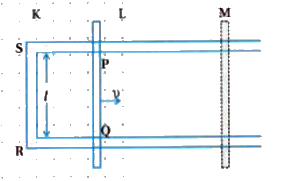
View SolutionRefer to fig. The arm PQ of the rectangular conductor is moved from x=0 outwards. The uniform magnetic field is perpendicular to the plane and extends from x=0 to x=b and is zero for . Only the arm PQ possesses substantial resistance r. Consider the situation when the arm PQ is pulled outwards from x=0 to x=2b, and is then moved back x=0 with constant speed . Obtain expressions for the flux the induced emf, the force necessary to pull the arm and the power dissipated as Joule heat. Sketch the variation of these quantities with distance.
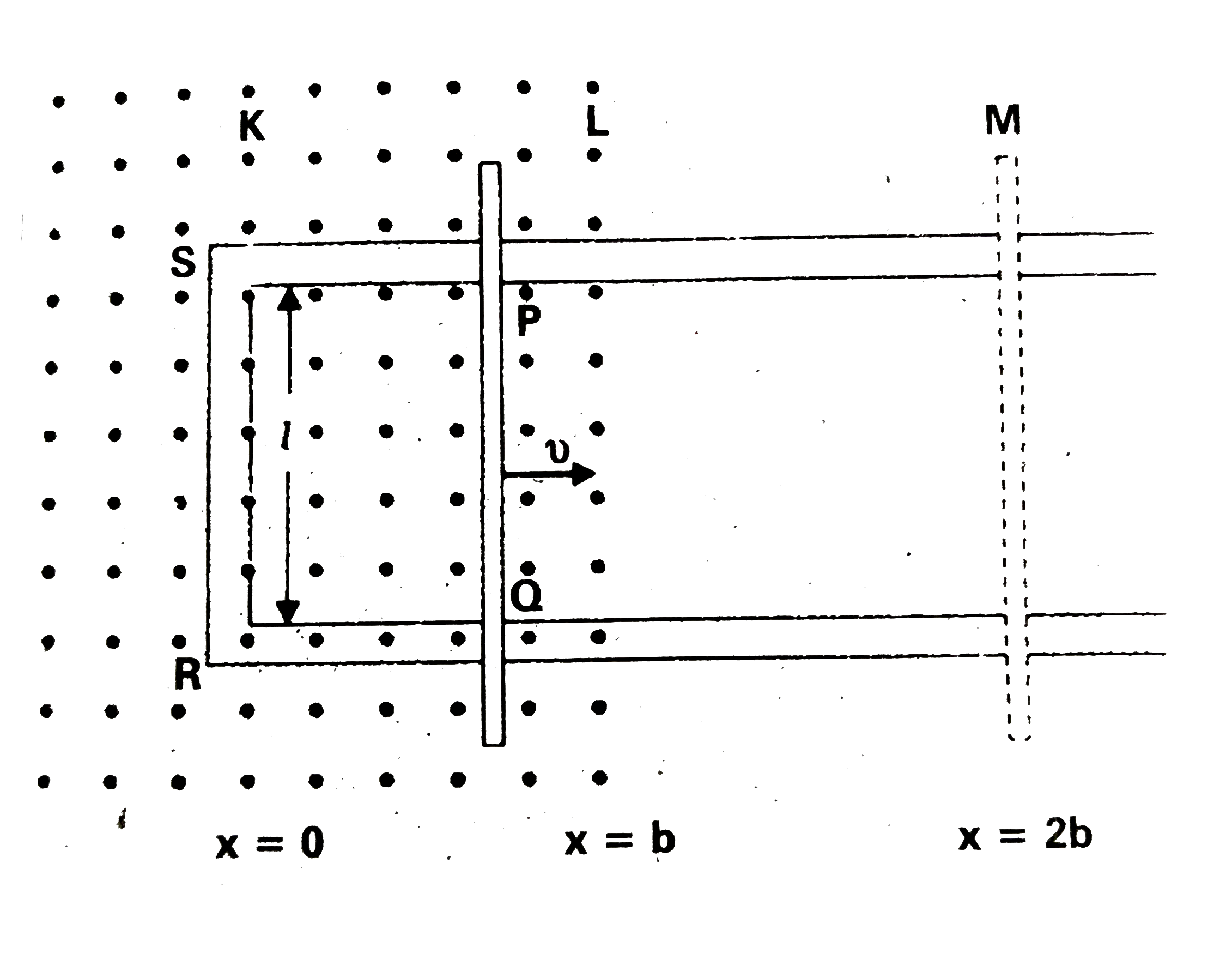
View SolutionThe arm of the rectangular conductor is moved from , outwards in the uniform magnetic field which extends from to and is zero for as shown. Only the arm possess substantial resistance . Consider the situation when the arm is pulled outwards from to , and is then moved back to with constant speed . Obtain expression for the flux, the induced emf, the force necessary to pull the arm and the power dissipated as Joule heat. Sketch the variation of these quantities with distance.
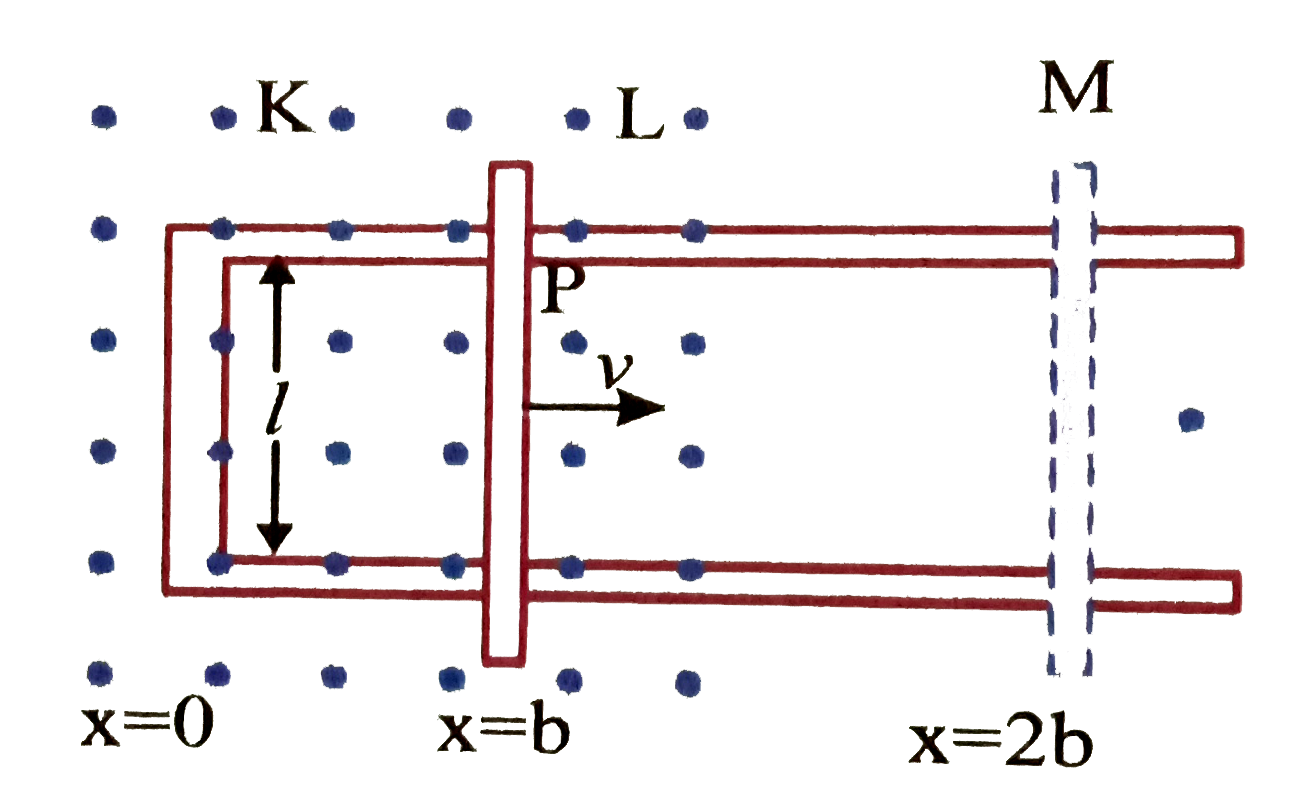
View Solutionफैराडे के वैद्युतचुम्बकीय प्रेरण का नियम बताएँ। चित्र में एक आयताकार चालक PQRS दिखाया गया है जिसमें चालक PQ, पृष्ठ के तल पर लम्बवत एकसमान चुम्बकीय क्षेत्र B में चलने में स्वतन्त्र है। क्षेत्र x = 0 से x = b तक फैला है और के लिए शून्य है। मान लें कि केवल भुजा PQ का ही प्रतिरोध r है। जब भुजा PQ, स्थिर वेग v से बाहर की ओर x = 0 से x = 2b तक खींच कर फिर x = 0 तक वापस लायी जाती है, तो फ्लक्स और प्रेरित विद्युत वाहक बल के लिए व्यंजक निकालें। इन राशियों दूरी के साथ परिवर्तन का चित्र बनाएँ।
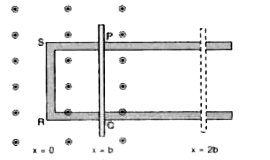
View SolutionThe arm PQ of the rectangular conductor is moved from x=0, outwards in the uniform magnetic field which extends from r=0 to x=b and is zero for x > b as shown. Only the arm PQ possesses substantial resistance r. Consider the situation when the arm PQ is pulled outwards from x = 0 to x = 2b, and is then moved back to x = 0 with constant speed v. Obtain expressions for the flux, the induced emf, the force necessary to pull the arm and the power dissipated as Joule heat. Sketch the variation of these quantities with distance.
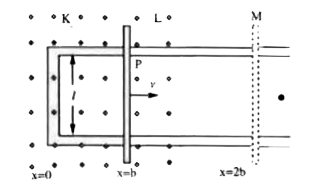
View SolutionIn the following diagram, the arm PQ of the rectangular conductor is moved from x = 0 ,
outwards.
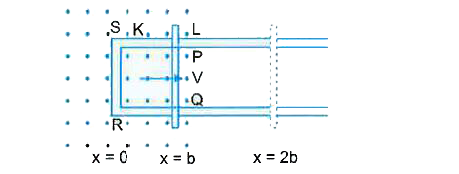
The unfirom magnetic field is perpendicular to the plane and extends from to and is zero for . Only the arm PQ possesses substantial resistance 'r'. Consider the situation when the arm PQ is pulled outwards from x = 0 to x = 2b, and then moved back to x = 0 with constant speed 'v'. Obtain expressions from the (i) magnetic flux, (ii) the induced emf, (iii) the force necessary to pull the arm and (iv) the power dissipated as joule heat.
Sketch the variation of these quantities with distance.
View SolutionThe arm PQ of the rectangular conductor is moved from , outwards. The uniform magnetic field is perpendicular to the plane and extends from to and is zero for . Only the arm. PQ possesses substantial resistance r. Consider the situation when the arm PQ is pulled outwards from to , and is then moved back to with constant speed v. Obtain expressions for the flux, the induced emf, the force necessary to pull the arm and the power dissipated as Joule heat. Sketch the variation of these quantities with distance.
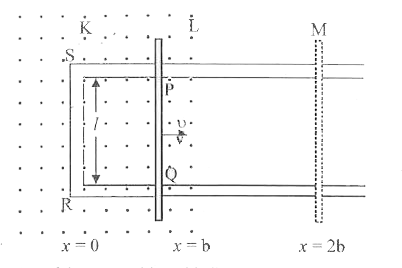
View SolutionThe arm of the rectangular conductor is moved from , outwards in the uniform magnetic field which extends from to and is zero for as shown. Only the arm possess substantial ressitance . Consider the situation when the arm is pulled outwards from to , and is then moved back to with constant speed . Obtain expression for the flux, the induced emf, the force necessary to pull the arm and the power dissipated as Joule heat. Sketch the variation of these quantities with distance.

View Solutionनीचे दिए गए चित्र में, आयताकार चालक की भुजा PQ स्थिति से बाहर की ओर चलती है। एकसमान चुम्बकीय क्षेत्र कागज के तलं के लम्बवत् अन्दर की ओर है। यह तक विस्तृत है तथा के लिए शून्य है। भुजा PQ का प्रतिरोध है। उस स्थिति का अवलोकन कीजिए जब भुजा PQ को तक तथा पुन: तक नियत चाल से चलाया जाता है। फ्लक्स व प्रेरित विद्युत
वाहक बल के लिए व्यंजक प्राप्त कीजिए।
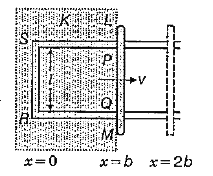
View SolutionThe arm PQ of a rectangular conductor is moving from x = 0 to x = 2b outwards and then inwards from x = 2b to x = 0 as shown in the figure. A uniform magnetic field perpendicular to the plane is acting from x = 0 to x = b. Identify the graph showing the variation of different quantities with distance :
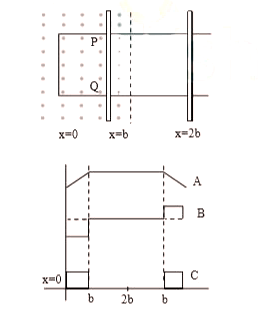
View Solutionचित्र को देखिए।आयताकार चालक की भुजा PQ को x = 0 से दायीं ओर चलाया जाता है। एकसमान चुंबकीय क्षेत्र तल के लंबवत है तथा x = 0 से x = b तक विस्तारित है तथा x>b के लिए शून्य है। केवल भुजा PQ में ही पर्याप्त प्रतिरोध है। उस स्थिति की कल्पना कीजिए जब भुजा PQ को x = 0 से x = 2b तक बाहर की ओर खींचा जाता है तथा पुनः स्थिर चाल सेx = 0 तक वापस ले जाते हैं। फ्लक्स, विद्युत वाहक बल, भुजा को खींचने के लिए आवश्यक बल तथा जूल ऊष्मा के रूप में क्षयित शक्ति के लिए व्यंजक प्राप्त कीजिए। इन राशियों में दूरी के साथ होने वाले परिवर्तन का ग्राफ भी खींचिए।
View Solutionचित्र 6.12 (a) को देखिए आयताकार चालक की भुजा PQ को x=0 से दायीं ओर चलाया जाता है एकसमान चुंबकीय क्षेत्र तल के लंबवत है तथा x=0 से x=b तक विस्तारित है तथा के लिए शून्य है | केवल भुजा PQ में ही पर्याप्त प्रतिरोध r है | उस स्थिति की कल्पना कीजिए जब भुजा PQ को x=0 से x=2b तक, बाहर की ओर खिंचा जाता है तथा पुनः स्थिर चाल v से x=0 तक वापस ले जाते है | फ्लक्स, प्रेरित विधुत वाहक बल, भुजा को खींचने के लिए आवश्यक बल तथा जूल ऊष्मा के रूप में क्षयित शक्ति के लिए व्यंजक प्राप्त कीजिए | इन राशियों में दुरी के साथ होने वाले परिवर्तन का ग्राफ भी खींचिए |
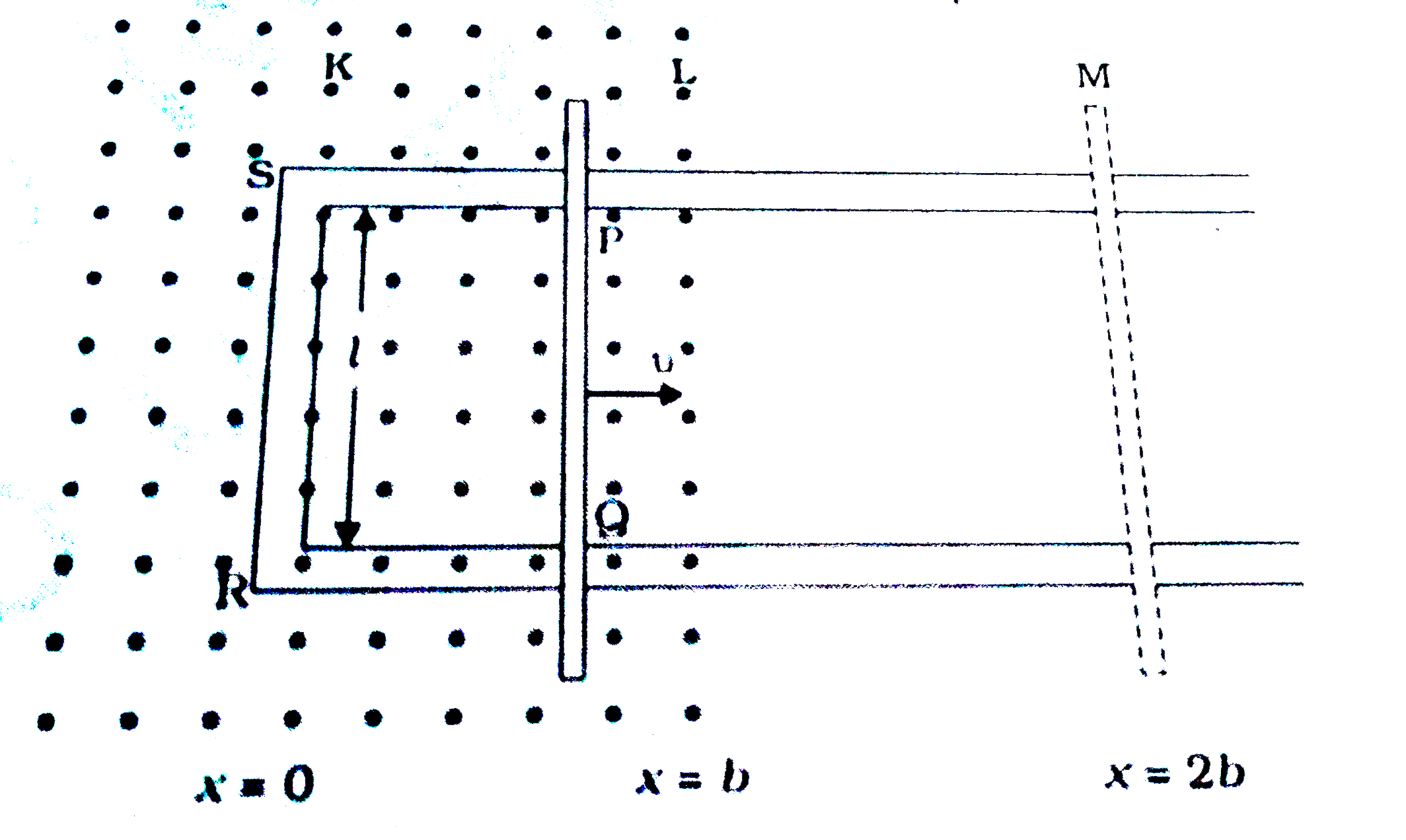
View SolutionFigure shows a rectangular loop conducting PQRS in which the arm PQ is free to move. A uniform magnetic field acts in the direction perpendicular to the plane of the loop. Arm PQ is moved with a valocity v towards the arm RS. Assuming that the arms QR, RS and SP have negligible resistances and the moving arm PQ has the resistance r, obtain the expression for (i) the current in the loop (ii) the force and (iii) the power required to move the arm PQ.

View SolutionFigure shows a rectangular loop conducting PQRS in which the arm PQ is free to move. A uniform magnetic field acts in the direction perpendicular to the plane of the loop. Arm PQ is moved with a valocity v towards the arm RS. Assuming that the arms QR, RS and SP have negligible resistances and the moving arm PQ has the resistance r, obtain the expression for (i) the current in the loop (ii) the force and (iii) the power required to move the arm PQ.
View SolutionFig. 6.50 shows a rectangular conducting loop PQRS in which the arm PQ is free to move. A uniform magnetic field acts in the direction perpendicular to the plane of the loop. Arm PQ is moved with a velocity v towards the arm RS. Assuming that the arms QR, RS and SP have negligible resistances and the moving arm PQ has the resistance r, obtain the expression for the current in the loop (ii) the force and (iii) the power required move the arm PQ.
View Solution